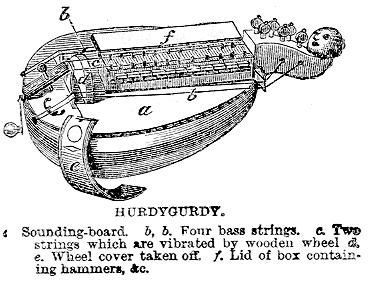Francoise Cotte and Brigitte Haudebourg - harpsichords
orchestra directed by Roger Cotte
The hurdy gurdy or hurdy-gurdy (also known as a wheel fiddle) is a stringed musical instrument that produces sound by a crank-turned rosined wheel rubbing against the strings. The wheel functions much like a violin bow, and single notes played on the instrument sound similar to a violin. Melodies are played on a keyboard that presses tangents (small wedges, usually made of wood) against one or more of the strings to change their pitch. Like most other acoustic string instruments, it has a soundboard to make the vibration of the strings audible.
During the Renaissance, the hurdy gurdy was a very popular instrument, along with the bagpipe, and a characteristic form with a short neck and a boxy body with a curved tail end developed. It was about this time that buzzing bridges first appear in depictions of the instrument. The buzzing bridge (commonly called the dog) is an asymmetrical bridge that rests under a drone string on the sound board. When the wheel is accelerated, one foot of the bridge lifts up from the soundboard and vibrates, creating a buzzing sound. The buzzing bridge is thought to have been borrowed from the tromba marina (monochord), a bowed string instrument.
During the late Renaissance, two characteristic shapes of hurdy gurdies developed. The first was guitar-shaped and the second had a rounded lute-type body made of staves. The lute body is especially characteristic of French instruments.
By the end of the 17th century changing musical tastes that demanded greater polyphonic capabilities than the hurdy gurdy could offer had pushed the instrument to the lowest social classes; as a result it acquired names like the German Bauernleier ‘peasant’s lyre’ and Bettlerleier ‘beggar’s lyre.’ During the 18th century, however, French Rococo tastes for rustic diversions brought the hurdy gurdy back to the attention of the upper classes, where it acquired tremendous popularity among the nobility, with famous composers writing works for the hurdy gurdy (the most famous of which is Nicolas Chédeville’s Il pastor Fido, attributed to Vivaldi). At this time the most common style of hurdy gurdy developed, the six-string vielle à roue. This instrument has two melody strings and four drones tuned such that by turning drones on or off, the instrument can be played in multiple keys (e.g., C and G or G and D).
During this time the hurdy gurdy also spread further east, where further variations developed in western Slavic countries, German-speaking areas and Hungary (see the list of types below for more information on these). Most types of hurdy gurdy were essentially extinct by the early twentieth century, but a few have survived—the best-known of which are the French vielle à roue, the Hungarian tekerőlant, and the Spanish zanfona. In Ukraine, a variety called the lira was widely used by blind street musicians, most of whom were purged by Stalin in the 1930s. Today the tradition has resurfaced. Revivals have been underway for many years as well in Sweden, Germany, Austria, Czech Republic, Poland, Russia, Italy, Spain and Portugal. The revival of hurdy gurdies has resulted in the instrument’s use in a variety of styles of music including contemporary forms not typically associated with the hurdy gurdy. (from Wikipedia)
Tracklisting:
1. Danse Royale {1:08}
unknown composer, for hurdy-gurdy and percussion
2. Danceries of Thoinot Arbeau {1:21}
unknown composer, for hurdy-gurdy and percussion
3. Suite of Contredances {3:37}
unknown composer, for hurdy-gurdy and tambuorine
4. Noce Champetre {3:39}
composed by Jean Hotteterre, for hurdy-gurdy, cello and harpsichord
5. "Laissez Paitre vos Betes" {1:54}
composed by Esprit Philippe Chedeville, for hurdy-gurdy and violin
6. Suite Pastorale {6:42}
composed by Charles Buterne, for hurdy-gurdy, harpsichord and bassoon
Side 2
1. "Il Pastor Fido" Sonata No. 1 {8:56}
composed by Antonio Vivaldi, for hurdy-gurdy, cello and harpsichord
2. "La Servante au Bon Tabac" {1:59}
composed by Michel Corrette, for hurdy-gurdy and orchestra
3. "Aire de Fanchon la Vielleuse" {1:18}
composed by J.D. Doche, hurdy-gurdy solo
4. German Dance No. 3 K. 602/Menuet No. 2 K. 601 {3:33}
composed by Wolfgang Amadeus Mozart, for hurdy-gurdy and orchestra
(Download Mediafire Link)


